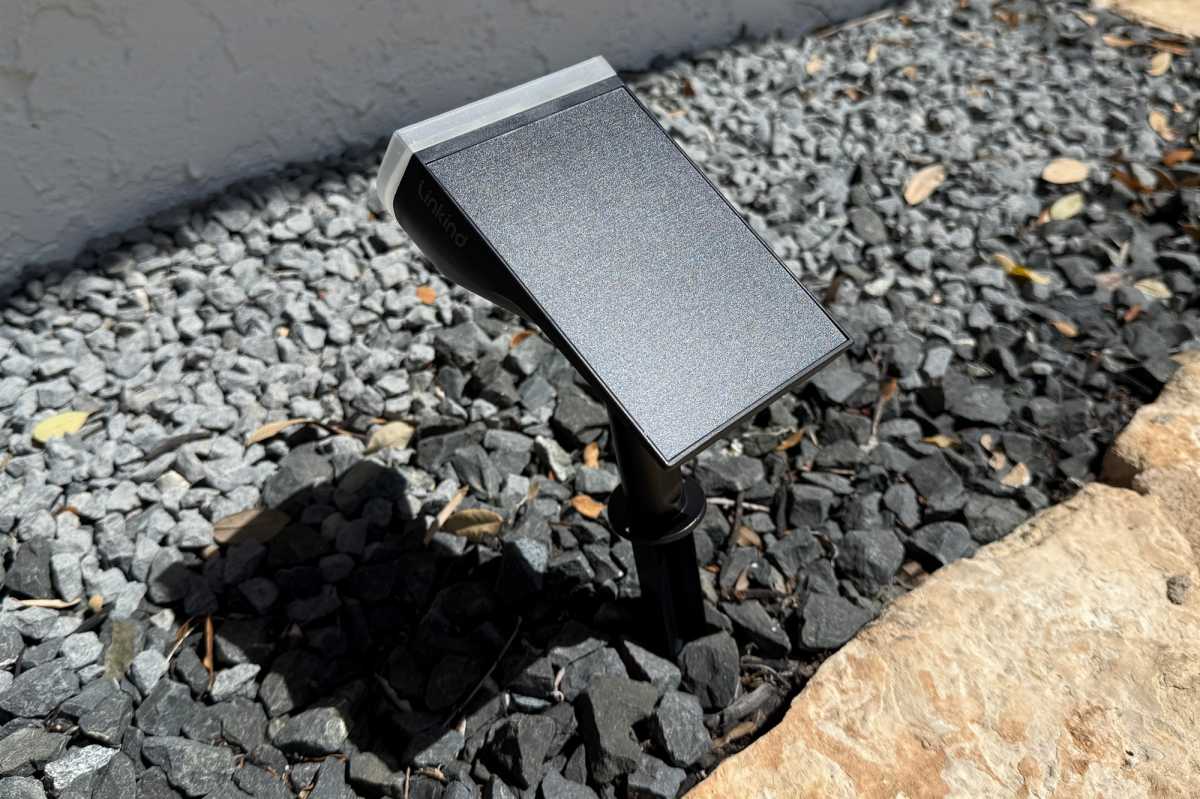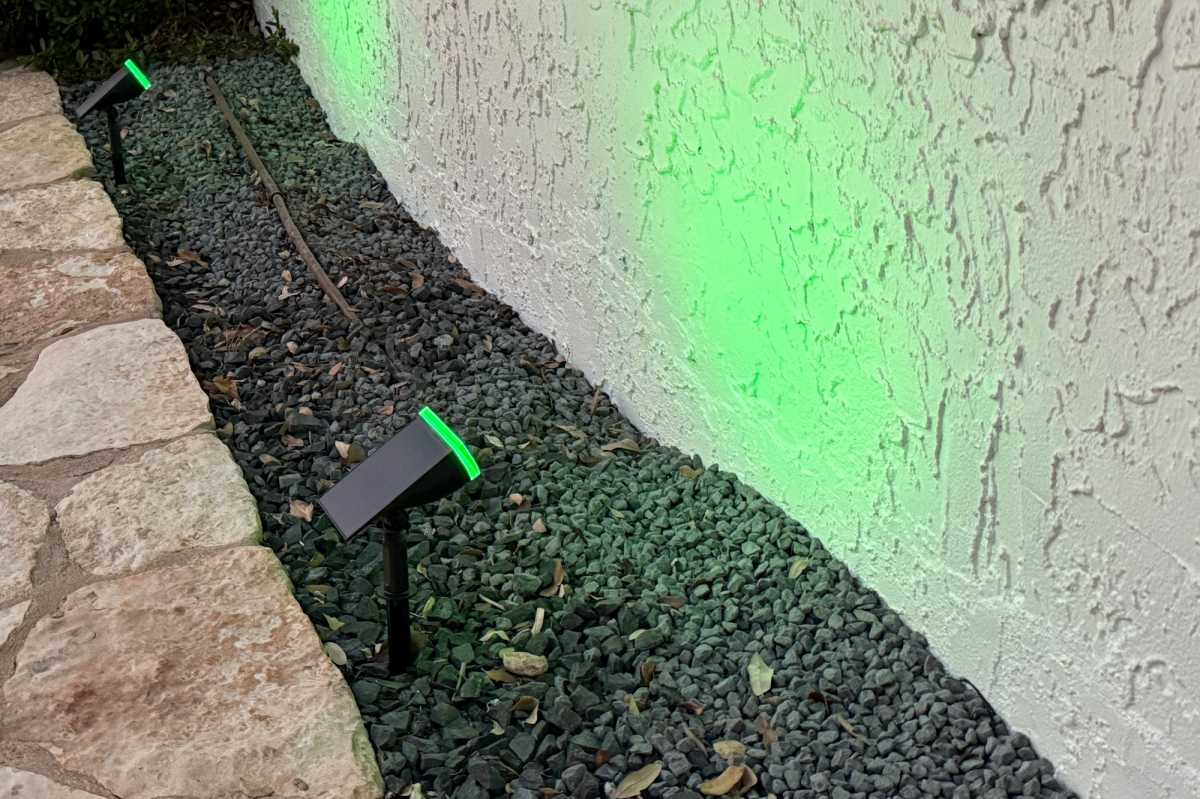Linkind Smart Solar Spotlight SL5C review: Light up your landscape
TechHive Editors Choice At a glanceExpert's Rating Pros Incredibly long battery life Amazingly bright in both white and color modes Surprisingly affordable Cons Management often requires tedious light-by-light configuration Dynamic color modes are a bit flat Battery meter in the app doesn’t update reliably Our Verdict Linkind’s solar-powered smart landscape spotlights offer exceptional lighting quality and crazy-long battery life, and they don’t need any wires at all. Price When Reviewed This value will show the geolocated pricing text for product undefined Best Pricing Today Traditional solar-powered path lights are some of the saddest home décor there is, their weak, dim beams suggesting that no one actually lives in the house they’re attempting to illuminate. These stick-and-go lights often seem forgotten by the homeowners that have jammed them into the earth, and who can blame them? The reality just doesn’t come close to matching the promise offered by the picture on the box. Linkind—whose interior smart bulb we recently covered—offers a tantalizing alternative: What if solar-powered path lights not only didn’t suck, but also included smart technology allowing for remote management? Specifications The Linkind Smart Solar Spotlight SL5C kit comes in a package of eight (a two-pack is also available) with a laminated solar panel on top of each housing. Two large banks of LEDs are inside each light, with a beam-focusing lens on its face. Note that these are directional spotlights, not ambient floods. Measuring about 6 x 3.5 inches, the IP65 water-resistant lights provide 3 watts of power, with their LEDs marketed as RGBTW—that’s red, green, blue, and tunable white. Linkind Smart Solar Spotlight SL5C are far brighter than your typical hardware store lights, and the colors are rich and lively. Linkind does not specify the wattage of the solar panel nor the size of the lights’ internal batteries, though the company says that when set to low-power mode (i.e., reduced brightness) they can run for up to 14 hours. (More on that in a bit.) They can be ground-mounted with plastic stakes or hung on a wall or other hard surface; hardware is included for either option. A simple thumbscrew allows you to adjust each light’s tilt angle. The entire top surface of each Linkind Smart Solar Spotlight SL5C features a very efficient laminated solar panel. Christopher Null/Foundry The SL5C is an update to Linkind’s older model SL5 lights, which look almost identical. The main upgrade here is higher solar-charging efficiency; both in charging speed and when charging under different weather conditions. Note, however, that the motion-sensing feature from the SL5 model has been removed from the SL5C. Since these lights don’t need—and don’t accommodate—any power source other than solar, users are directed to place them in the sun for at least a full day before even turning them on. That’s done via a single button on the bottom of each device that not only powers the lights on and off, but that can be used to cycle the lights through a handful of primary colors and two white color temperatures. Anything more requires the AiDot mobile app (AiDot is Linkind’s parent company). Connectivity Given the power limitations of the device, it’s understandable that its smart/wireless features are limited to Bluetooth mesh; as such, there’s not much to the setup process within the AiDot app. A quick discovery process turns up each lighting unit separately and drops you directly into color management and scheduling options once firmware has been brought up to date. The Linkind Smart Solar Spotlight SL5C can glow in numerous colors or tunable white, and the batteries last a good long time given adequate sunshine during the day.Christopher Null/Foundry The lights support white color temperatures from a warm 2700K to a cool 6500K, or you can use a color wheel to dial in the specific hue of your choice from millions of options. Some 43 presets are included that enable various dynamic lighting modes, including a music-sync option that works with your phone’s microphone. Linkind all but forces you to use a scheduling system with the lights, either one that is strictly tied to the time of day or one that uses both time of day and ambient light level (“luminance detection”) to turn on and off. You need not use time restrictions with the latter if you want the lights to run all night but note that the lights are strictly designed to run in dark conditions. The only way to get the lights to operate during daylight is to cover the solar panel completely to emulate night. Performance The lights look good under the cloak of darkness. They are far brighter than your typical hardware store lights, and the colors are rich and lively. I found the dynamic modes to be a little flat—and the music mode is not very impressive—b

Expert's Rating
Pros
- Incredibly long battery life
- Amazingly bright in both white and color modes
- Surprisingly affordable
Cons
- Management often requires tedious light-by-light configuration
- Dynamic color modes are a bit flat
- Battery meter in the app doesn’t update reliably
Our Verdict
Linkind’s solar-powered smart landscape spotlights offer exceptional lighting quality and crazy-long battery life, and they don’t need any wires at all.
Price When Reviewed
This value will show the geolocated pricing text for product undefined
Best Pricing Today
Traditional solar-powered path lights are some of the saddest home décor there is, their weak, dim beams suggesting that no one actually lives in the house they’re attempting to illuminate. These stick-and-go lights often seem forgotten by the homeowners that have jammed them into the earth, and who can blame them? The reality just doesn’t come close to matching the promise offered by the picture on the box.
Linkind—whose interior smart bulb we recently covered—offers a tantalizing alternative: What if solar-powered path lights not only didn’t suck, but also included smart technology allowing for remote management?
Specifications
The Linkind Smart Solar Spotlight SL5C kit comes in a package of eight (a two-pack is also available) with a laminated solar panel on top of each housing. Two large banks of LEDs are inside each light, with a beam-focusing lens on its face. Note that these are directional spotlights, not ambient floods. Measuring about 6 x 3.5 inches, the IP65 water-resistant lights provide 3 watts of power, with their LEDs marketed as RGBTW—that’s red, green, blue, and tunable white.
Linkind Smart Solar Spotlight SL5C are far brighter than your typical hardware store lights, and the colors are rich and lively.
Linkind does not specify the wattage of the solar panel nor the size of the lights’ internal batteries, though the company says that when set to low-power mode (i.e., reduced brightness) they can run for up to 14 hours. (More on that in a bit.) They can be ground-mounted with plastic stakes or hung on a wall or other hard surface; hardware is included for either option. A simple thumbscrew allows you to adjust each light’s tilt angle.

The entire top surface of each Linkind Smart Solar Spotlight SL5C features a very efficient laminated solar panel.
Christopher Null/Foundry
The SL5C is an update to Linkind’s older model SL5 lights, which look almost identical. The main upgrade here is higher solar-charging efficiency; both in charging speed and when charging under different weather conditions. Note, however, that the motion-sensing feature from the SL5 model has been removed from the SL5C.
Since these lights don’t need—and don’t accommodate—any power source other than solar, users are directed to place them in the sun for at least a full day before even turning them on. That’s done via a single button on the bottom of each device that not only powers the lights on and off, but that can be used to cycle the lights through a handful of primary colors and two white color temperatures. Anything more requires the AiDot mobile app (AiDot is Linkind’s parent company).
Connectivity
Given the power limitations of the device, it’s understandable that its smart/wireless features are limited to Bluetooth mesh; as such, there’s not much to the setup process within the AiDot app. A quick discovery process turns up each lighting unit separately and drops you directly into color management and scheduling options once firmware has been brought up to date.

The Linkind Smart Solar Spotlight SL5C can glow in numerous colors or tunable white, and the batteries last a good long time given adequate sunshine during the day.
Christopher Null/Foundry
The lights support white color temperatures from a warm 2700K to a cool 6500K, or you can use a color wheel to dial in the specific hue of your choice from millions of options. Some 43 presets are included that enable various dynamic lighting modes, including a music-sync option that works with your phone’s microphone.
Linkind all but forces you to use a scheduling system with the lights, either one that is strictly tied to the time of day or one that uses both time of day and ambient light level (“luminance detection”) to turn on and off. You need not use time restrictions with the latter if you want the lights to run all night but note that the lights are strictly designed to run in dark conditions. The only way to get the lights to operate during daylight is to cover the solar panel completely to emulate night.
Performance
The lights look good under the cloak of darkness. They are far brighter than your typical hardware store lights, and the colors are rich and lively. I found the dynamic modes to be a little flat—and the music mode is not very impressive—but if all you’re looking for is a pop of light after dark, these lights get the job done.
Battery life is even better than promised. I started off running the lights for four hours each night at full brightness and regularly observed a fully charged battery by midday the following day. When running them without a time restriction, I managed to get more than 22 hours of running time at 100 percent brightness, far better than the 14 hours Linkind promises. While the battery meter indicator didn’t update reliably in the app, I didn’t encounter any real issues with the product.

The spotlights come with both a ground stake and a bracket for mounting to a wall or other hard surface. A pivot mechanism allows you to aim the light up or down.
AiDot/Linkind
What’s not to like here? The major problem with this setup is that each light must be managed individually, which means up to eight firmware updates, eight automation mode settings, and eight scheduling operations. On-demand color and dynamic modes can be set for “all lights” en masse, but you can’t do that for schedules.
Modes and schedules can, however, be “copied” from one light to another through a slightly buried menu item. You’ll also need to make sure you’re in Bluetooth range of each light when controlling it. This could present challenges if you’ve spread the lights over a long pathway, but once a schedule is configured to your liking, you can essentially set things up once and then forget about it.

The lights operate over Bluetooth mesh, so the AiDot app allows you to control each light individually or you can assign the same values to all of them at once.
Christopher Null/Foundry
There’s a workaround here in the form of the Linkind B1 Plus Hub, which I have not reviewed. It’s a Bluetooth bridge that lets you control up to 32 lights en masse from up to 120 feet from the bridge and the first spotlight. Each spotlight must likewise be no more than 120 feet apart, assuming there are no substantial obstructions between them.
That still won’t be enough distance for even moderately sized homesteads, but it’s at least a start. The hub also allows you to connect the lights to Alexa or Google Assistant, which can’t otherwise be done with the naked lights. The bridge was on sale for $30 at the time of this writing, not including an AC adapter.
Should you buy the Linkind Smart Solar Spotlight SL5C?
An 8-pack of these second-gen landscape spotlights runs $130, while a 2-pack costs $35. (Limited-time launch discounts cut those prices to $91 and $25 respectively.) The larger bundle is a bit pricier than the older Linkind SL5 ($77 for a 6-pack), but it is still a very good deal, provided the slightly bulky design works for your aesthetic.
While I would normally hesitate to recommend solar-powered lights to anyone, Linkind’s Solar Spotlights SL5C have me rethinking my position.




























![[Webinar] AI Is Already Inside Your SaaS Stack — Learn How to Prevent the Next Silent Breach](https://blogger.googleusercontent.com/img/b/R29vZ2xl/AVvXsEiOWn65wd33dg2uO99NrtKbpYLfcepwOLidQDMls0HXKlA91k6HURluRA4WXgJRAZldEe1VReMQZyyYt1PgnoAn5JPpILsWlXIzmrBSs_TBoyPwO7hZrWouBg2-O3mdeoeSGY-l9_bsZB7vbpKjTSvG93zNytjxgTaMPqo9iq9Z5pGa05CJOs9uXpwHFT4/s1600/ai-cyber.jpg?#)














































































































































![[The AI Show Episode 144]: ChatGPT’s New Memory, Shopify CEO’s Leaked “AI First” Memo, Google Cloud Next Releases, o3 and o4-mini Coming Soon & Llama 4’s Rocky Launch](https://www.marketingaiinstitute.com/hubfs/ep%20144%20cover.png)




































































































































































































![Rogue Company Elite tier list of best characters [April 2025]](https://media.pocketgamer.com/artwork/na-33136-1657102075/rogue-company-ios-android-tier-cover.jpg?#)








































































_Andreas_Prott_Alamy.jpg?width=1280&auto=webp&quality=80&disable=upscale#)



























































































![What’s new in Android’s April 2025 Google System Updates [U: 4/18]](https://i0.wp.com/9to5google.com/wp-content/uploads/sites/4/2025/01/google-play-services-3.jpg?resize=1200%2C628&quality=82&strip=all&ssl=1)










![Apple Watch Series 10 Back On Sale for $299! [Lowest Price Ever]](https://www.iclarified.com/images/news/96657/96657/96657-640.jpg)
![EU Postpones Apple App Store Fines Amid Tariff Negotiations [Report]](https://www.iclarified.com/images/news/97068/97068/97068-640.jpg)
![Apple Slips to Fifth in China's Smartphone Market with 9% Decline [Report]](https://www.iclarified.com/images/news/97065/97065/97065-640.jpg)



































































































































